The Hesperornithiforms
were a distinctive group of toothed Birds that appeared in the Early
Cretaceous and persisted till the end of that period. They are
thought to have been among the first Birds to adapt to an aquatic
lifestyle, apparently having been powerful swimmers with proportion
driven by the enlarged hind legs, though like other Cretaceous
toothed Bird groups they are not thought to have any living
descendants.
In a paper published in
the journal PLoS One on 18 November 2015, Alyssa Bell and Luis
Chiappe of the Dinosaur Institute at the Natural History Museum ofLos Angeles County, describe a new species of Hesperornithiform Bird
from the Late Cretaceous Smoky Hill Member of the Niobrara Chalk of
Kansas.
The species is named
Fumicollis hoffmani, where 'Fumicollis' means 'Smoke
Hill' in Latin and 'hoffmani' honours Karen and Jim Hoffman
for their generous support of the Natural History Museum of Los
Angeles County and in particular the Dinosaur Institute. The species
is described from a single specimen, which was initially discovered
in 1937 and thought to be a specimen of Baptornis advenus, but
which has now been shown to be a separate species. The specimen
comprises eight vertebrae, numerous fragments of ribs, plus most of
the ilium, ischium, and pubis, some of the left half of the pelvis,
part of the pygostyle (tailbone made from fused vertebrae), most of
the left hindlimb and part of the right.
Reconstruction of
Fumicollis hoffmani. Bell &
Chiappe (2015).
Fumicollis hoffmani
shows a mixture of traits seen
in other Late Cretaceous Hesperornithiforms and more 'primitive'
traits seen in earlier members of the group. However Bell and Chiappe
believe that the 'primitive' traits of Fumicollis hoffmani
relate to its size; most known
Late Cretaceous Hesperornithiforms
were quite large, while earlier members of the group were generally
small.
The
Smokey Hills Member is thought to have been laid down over a period
of about five million years, but has produced a rich and diverse
assemblage of Hesperornithiforms. This does not necessarily mean
that all the species were present at the same time, though it leaves
a very limited period for different species to replace one-another.
Bell and Chiappe suggest that the diverse assemblage potentially
represents an assemblage of Birds with different ecological
requirements living in the same area. This can be seen today in
Penguins around the Antarctic Peninsula and nearby islands, where up
to six different species can be found living in the same area. While
the Penguins are all essentially similar, being aquatic Birds feeding
on Fish, the different species are all different sizes, and therefore
feed at different depths, allowing the different species to live in
the same area without directly competing with one-another.
See
also...
 Preserved feathers in an Enantiornithine Bird from the Early Cretaceous Crato Formation of Brazil. While feathers have been known in
fossil Birds from...
Preserved feathers in an Enantiornithine Bird from the Early Cretaceous Crato Formation of Brazil. While feathers have been known in
fossil Birds from... Preserved stomach contents in Early Cretaceous Ornithuromorph Birds. The Early Cretaceous Jehol Group of China has produced a remarkable
number of well-preserved fossils of Mesozoic Birds, adding greatly to our
understanding of the early history of this group...
Preserved stomach contents in Early Cretaceous Ornithuromorph Birds. The Early Cretaceous Jehol Group of China has produced a remarkable
number of well-preserved fossils of Mesozoic Birds, adding greatly to our
understanding of the early history of this group... Bird eggs from a Late Cretaceous colonial nesting site in Argentinean Patagonia. In the 1980s a large collection of Avian eggs were uncovered at the
campus of the National University of Comahue at Neuquén City in Argentinean
Patagonia. These ages were located on a single bedding...
Bird eggs from a Late Cretaceous colonial nesting site in Argentinean Patagonia. In the 1980s a large collection of Avian eggs were uncovered at the
campus of the National University of Comahue at Neuquén City in Argentinean
Patagonia. These ages were located on a single bedding...
Follow Sciency Thoughts on Facebook.

